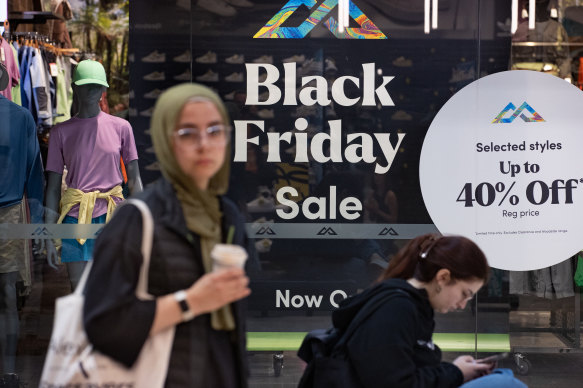Save articles for later
Add articles to your saved list and come back to them any time.
Black Friday sales are starting earlier as businesses fight to attract shoppers on the hunt for pre-Christmas bargains while juggling cost-of-living pressures.
The Australian Retailers Association expects Australians to spend $6.36 billion over the four-day Black Friday sale period alone. But chief executive Paul Zahra said some retailers, worried about the continuing fall in consumer spending, had decided to start their sales early.
Black Friday sales are starting early this year as retailers compete for budget-conscious shoppers’ dollars.Credit: Simon Schluter
“They’re concerned about trade, so they’re pulling the lever on starting the sale earlier,” Zahra said.
More sales will begin early next week, he said, with uncertainty about a potential December interest rate rise from the Reserve Bank looming over the economy driving shoppers to do the vast bulk of their holiday spending over the Black Friday sales.
“People are shopping earlier; they’re looking for a deal, they’re looking for value, and they’re shopping with a particular budget in mind,” Zahra said.
Woolworths and Samsung are among a handful of businesses that have already kicked off discounts for shoppers ahead of next week’s Black Friday weekend.
Last Friday, Samsung launched a “secret price slash” for 24 hours only on home appliances and also launched a broader ‘TGI Black Friday’ flash sale that offers reduced prices every Friday for the month of November.
While Australians are hunting for ways to spend less on Christmas shopping, consumers are seeking relief in the grocery aisle as well: Everyday Rewards has unveiled an ‘Orange Friday’ sales event across Woolworths, Big W, and its other businesses.
Customers can expect reduced prices on staples including some instant coffees and toilet paper as well as other items from November 15 to 21.
Research from Finder.com.au shows Australians are expected to spend $727 per person on the Black Friday sales.
Discretionary retailers will generally make up to two-thirds of their yearly profit through the holiday trading period, Zahra said, but this year household budgets were under extreme pressure from the cost-of-living crisis.
“Now, this is a complete reverse of what we saw the last two Christmases, because people were record spending, there was a lot of what we call freedom spending … but this year, it’s a very different proposition,” he said.
“This is very much a budget-conscious customer. That’s probably the best way to describe the Christmas spend,” he said.
Ahead of the sales, consumer spending has slowed after a resilient few months, according to the Commonwealth Bank’s household spending index.
The bank’s senior economist Belinda Allen said the question was whether consumers had held back spending ahead of this month’s sales, or whether the Reserve Bank’s November interest rate hike, which took the official cash rate to 4.35 per cent, would keep spending soft.
“What it’s showing is, when there’s no reason to spend, consumers are winding back,” the bank’s senior economist Belinda Allen said.
The Commonwealth data showed consumers had reduced spending at furniture stores, appliance stores, luxury boutiques and jewellery stores, which was partially offset by some higher spending on online marketplaces and used and second-hand goods stores.
Allen said this was building on a trend the bank has seen over the course of the year.
“We have seen it in terms of consumers [who are] trading down brands, trading down quality of goods as well,” she said.
“That’s just another example of how consumers are making decisions to help them in terms of the cost-of-living pressures.”
Cut through the noise of federal politics with news, views and expert analysis from Jacqueline Maley. Subscribers can sign up to our weekly Inside Politics newsletter here.
Most Viewed in Politics
From our partners
Source: Read Full Article

